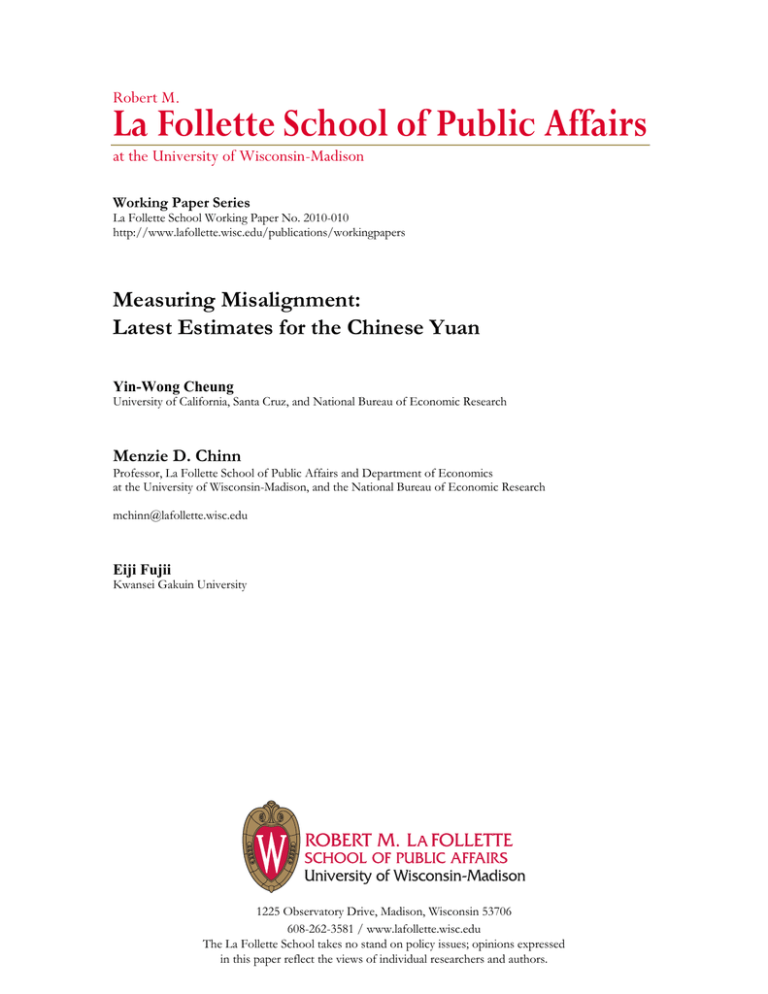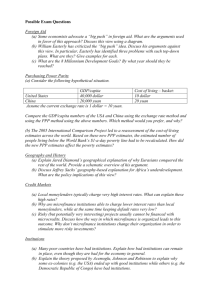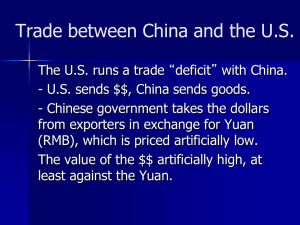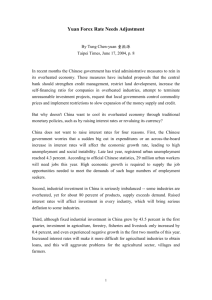La Follette School of Public Affairs Robert M. Working Paper Series
advertisement

Robert M. La Follette School of Public Affairs at the University of Wisconsin-Madison Working Paper Series La Follette School Working Paper No. 2010-010 http://www.lafollette.wisc.edu/publications/workingpapers Measuring Misalignment: Latest Estimates for the Chinese Yuan Yin-Wong Cheung University of California, Santa Cruz, and National Bureau of Economic Research Menzie D. Chinn Professor, La Follette School of Public Affairs and Department of Economics at the University of Wisconsin-Madison, and the National Bureau of Economic Research mchinn@lafollette.wisc.edu Eiji Fujii Kwansei Gakuin University 1225 Observatory Drive, Madison, Wisconsin 53706 608-262-3581 / www.lafollette.wisc.edu The La Follette School takes no stand on policy issues; opinions expressed in this paper reflect the views of individual researchers and authors. Measuring Misalignment: Latest Estimates for the Chinese Yuan Yin-Wong Cheung* University of California, Santa Cruz Menzie D. Chinn** University of Wisconsin, Madison and NBER Eiji Fujii† Kwansei Gakuin University April 20, 2010 Acknowledgments: Paper prepared for The US-Sino Currency Dispute: New Insights from Economics, Politics and Law (VoxEU), edited by Simon Evenett. The views expressed are solely those of the authors and do not necessarily represent the views and opinions of institutions with which the authors are, or have been, associated. * Corresponding Author: Department of Economics, University of California, Santa Cruz, CA 95064. Tel/Fax: +1 (831) 459-4247/5900. Email: cheung@ucsc.edu ** Robert M. LaFollette School of Public Affairs, and Department of Economics, University of Wisconsin, 1180 Observatory Drive, Madison, WI 53706-1393. Tel/Fax: +1 (608) 262-7397/2033. Email: mchinn@lafollette.wisc.edu † School of Economics, Kwansei Gakuin University, 1-155 Uegahara 1-bancho, Nishinomiya, Hyogo 662-8501, Japan. Tel: +81 798 54 7257. Fax: +81 798 51 0944. E-mail: efujii@kwansei.ac.jp 1 1. Introduction Few phrases in open economy macroeconomics excite so much attention, but elicit so little understanding, as “currency misalignment”. The reason for this state of affairs is not very difficult to understand: each different observer uses the phrase in a different way, incorporating different models and different assumptions. No episode in recent history validates this thesis better than the past decade’s debate over the Chinese yuan’s appropriate valuation. In this chapter, we re-orient the discussion of currency misalignment back toward theory and empirics; in particular, we set forth a typology of modeling approaches used to assess misalignment, in order to highlight the difficulties in defining the “equilibrium (real) exchange rate” in theory, and in quantifying the extent of deviations from equilibrium in practice. We then recap recent estimates of yuan misalignment. 2. A Typology and Literature Review The literature on the exchange rate misalignment, even when restricted to the Chinese yuan, is voluminous and diverse. Hence, it is helpful to lay out a typology of approaches.1 Most of these theoretical approaches fall into familiar categories: • Relative purchasing power parity (PPP) • Absolute purchasing power parity and the “Penn Effect” • The productivity approach and the behavioral equilibrium exchange rate (BEER) approach 1 • The macroeconomic balance effect • The underlying or basic balance approach Hinkle and Montiel (1999), Cheung, Chinn and Fujii (2009a). 2 2.1 Relative PPP Relative PPP asserts that the nominal exchange rate moves with relative price levels in the long run, up to a constant. In other words: 1 Ψ , (1) where S is the exchange rate expressed as Chinese yuan per unit of foreign currency, P is the Chinese price index, P* is the foreign price index, and the constant (1+ψ) accounts for the fact that the indexes are just that – indexes, with given base years. Nobody expects that relative PPP holds in the short run, but it’s plausible to argue that it would hold in the long run. Equation (1) as a long run relationship implies that the real exchange rate would revert to the average value (1+ψ): / 1 Ψ , (2) where Q is the real exchange rate. Application of this method requires the assumption that at least at some time over the sample period, the exchange rate has been at its equilibrium level – and for the Chinese currency, this is a difficult proposition to maintain. To illustrate this contention, consider the log trade weighted real value of the Chinese yuan, in Figure 1 (the series is log(1/Q)).2 Using the mean over the 1980-2009 period leads to the conclusion that the yuan is only slightly undervalued in December 2009 – 7.5% (all misalignment in log terms unless otherwise stated). Even if one allows for some sort of time trend in ψ, whether the currency is deemed to be overvalued or undervalued depends critically on the sample period used to estimate the trend; using the 1980-2009 sample, one finds a 36% overvaluation. 2 The series is spliced at 1994 to an older IMF series which accounts for the fact that some transactions were conducted at “swap market” rates rather than official rates. See the discussion in Fernald, Edison and Loungani (1999). 3 6.0 Log trade weighted real value of CNY 5.6 5.2 Mean 1980-2009 4.8 4.4 Trend 1980-2009 4.0 1980 1985 1990 1995 2000 2005 2010 Figure 1: Log trade weighted real value of the Chinese yuan, deflated using CPIs. Upward direction indicates appreciation. Red line is mean value over 1980-2009 period. Green line is linear trend estimated over 1980-2009 period. Source: IMF, International Financial Statistics, various issues, and authors’ calculations. Clearly, one can get pretty much any answer one wants by judicious choice of sample period. For instance, using a shorter, 1990-2009, sample, the yuan is overvalued by 13.5% and 1.6% using the mean and trend, respectively. Further note that the standard calculation of the real exchange rate uses consumer price indices (CPIs). One could use alternative deflators, such as producer price indices, or unit labor costs (Chinn, 2006). Doing so would provide alternative conclusions regarding differing estimates of misalignment.3 2.2 Absolute PPP and the “Penn Effect” 3 For the real exchange rate to be stationary, the exchange rate and price indices must be cointegrated with unit coefficients (Chinn, 2000a). 4 It seems like one could get around the problem of estimating (1+ψ) by using actual prices of identical bundles of goods across countries, rather than price indices. Now P and P* represent prices of identical bundles of goods . (3) In principle one can see then whether the “price level” differs between countries. One practical problem is that prices of identical bundles of goods are not usually available on a consistent basis. The “price levels” constructed by Summers and Heston (1991) and reported in the Penn World Tables, or in the related World Bank World Development Indicators, circumvent this problem by constructing the price levels in a way that they pertain to similar bundles across countries. One can then examine whether: 1/ / (4) is equal to one across countries. Figure 2 presents a scatter plot of the observations on R for over 170 countries over the period 1980-2008, using the most recent vintage of data the World Bank’s World Development Indicators. If absolute PPP held, then one would expect that the scatter plot of observation to align horizontally. In fact, the scatter of observations slopes upward – in words, higher income countries evidence higher prices. 5 Real exchange rate 2 1 China 2008 China 1980 0 -1 -2 China 1993 -3 -4 -6 -5 -4 -3 -2 -1 0 1 2 Relative per capita income in PPP terms Figure 2: Log real exchange rate R and log per capita income relative to US, expressed in PPP terms. Upward direction indicates appreciation. Solid blue line denotes regression line; long (short) dashed lines represent ±1 (±2) standard error bands. Red line denotes path of the RMB over time. Source: World Bank, World Development Indicators (accessed March 2010) and author’s calculations. A similar pattern obtains if one uses a bundle called a Big Mac (Parsley and Wei, 2003), popularized by the Economist. Express the prices of Big Macs across the globe in dollar terms, and one finds a positive correlation between per capita income and the US dollar price of a Big Mac. 6 Absolute PPP using Big Mac’s indicates a January 2010 undervaluation of 67%.4 This is not too dissimilar to the approximately 50% undervaluation (the distance from the 0 line to the China 2008 observation) shown in Figure 2. The positive exchange rate – income relationship illustrated in Figure 2 is so robust that it has a name --“The Penn Effect”, after the Penn World Tables. Instead of viewing the Penn Effect as a problem, one can exploit this stylized fact. Following Frankel (2005), estimate the relationship between (log) R and log relative per capita income, and interpret the deviation from this line as the degree of misalignment. The elasticity of the price level with respect to relative per capita income is 0.2. The regression coefficient is plotted in the graph as the solid blue line.5 The path of the yuan, and particularly the 2008 end-point, in Figure 2 appears counterintuitive. The yuan is estimated to be overvalued by 5% by 2008. In Cheung, Chinn and Fujii (2007), we exploited this relationship using data up to 2004 and found an yuan misalignment in excess of 50%. What explains the large change in the estimated degree of yuan undervaluation? In 2008, the International Comparison Program reported the results of a new benchmark survey of prices, conducted in 2005. These new estimates were incorporated into their comprehensive revision of the World Development Indicators database. While the estimates for many countries were affected, China’s price and income data were substantially modified in light of the new benchmark data (Elekdag and Lall, 2008). The Chinese price level was revised approximately 40% upward, and hence Chinese per capita income downward by roughly the same amount. 4 The US price is $3.58, while the Chinese price (converted in dollars) is $1.83; in level terms, this is a 50% undervaluation. See Economist (2010). 5 Ferguson and Schularick (2009) apply a variant of this approach to ten emerging market economies relative to the United States. In their case R is the dollar wage rate. By this criterion, the yuan is undervalued by 34% to 48% (in level terms). 7 Using updated data, we found something closer to 10% undervaluation in 2007 (with the 2004 estimated misalignment reduced to 18%). The 2008 yuan overvaluation of 5% is obtained from the most recent vintage of the WDI. While Chinese per capita income has risen about 15% by end-2009, and the equilibrium rate should have risen by about 2.8%, the trade weighted real exchange rate is about the same now as it was in 2008; thus according to our calculations, the yuan remains slightly overvalued.6 Note that while we cannot reject the no-misalignment null, we also can not reject the 20% undervaluation null hypothesis at conventional significance levels. This outcome highlights the lack of precision of our estimates. Subramanian (2010) recently published estimates that contrast with ours. He argues that it is best to estimate the slope coefficient off benchmark data years, with the last one being 2005. Using this approach, he finds the 2005 undervaluation to be 14.5% and 47.5% (in level terms), using the World Development Indicators and Penn World Tables, respectively. Extrapolating the path of the equilibrium exchange rate using income growth over the intervening period, he concludes that the current degree of undervaluation is roughly the same as it was in 2005.7 2.3 The Productivity Approach and the Behavioral Equilibrium Exchange Rate Approach The most common way of incorporating productivity in exchange rate determination is the Balassa-Samuelson theory, which focuses on the differential between traded and nontraded 6 According to IMF World Economic Outlook database, year on year growth in per capita GDP is about 10% in both 2009 and 2010. Using this growth rate, and the 0.2 coefficient estimate yields the implied 2.8% appreciation. 7 Reisen (2009) uses the 2008 cross section and obtains a 12% undervaluation (in levels). We obtain similar results to Subramanian and to Reisen, for 2005 and 2008 respectively. 8 sectors. To our knowledge, few researchers have attempted to estimate the link between sectoral productivity trends and the real exchange rate for China, with the exception of Chinn (2000). The impact of productivity differentials can be illuminated in a highly simplified version of the Balassa-Samuelson model. Suppose the economy price level is the average of the prices of tradable and nontradable goods. If the relative price of nontradables moves inversely with the relative productivity levels in the two sectors, then the faster tradable productivity grows, relative to nontradables (relative to the same ratio in the foreign country), then the stronger the exchange rate.8 A highly simplified version of this approach can be expressed as: / , (5) where α is the share of nontradables in the total basket of goods, and A is total factor productivity in sector i (i = N, T). Cheung, Chinn and Fujii (2009b) implement this approach. The estimation procedure is hampered by the onerous data requirements, specifically estimates of productivity levels in the tradable and nontradable sectors.9 Estimates of equation (5) over the 1988-2004 period imply that the Chinese yuan was undervalued in 2004 by as much as 6.1%, and as little as 1.4%, depending on the productivity series used. The preceding approach restricted the exchange rate determinants to solely productivity differentials. One can allow for other effects by augmenting the productivity variable with other variables, such as real interest differentials, government spending, or the terms of trade. These 8 PPP must hold for traded goods, capital must be perfectly mobile internationally, and the factors of production must be free to move between sectors. 9 Following Chinn (2000b), average labor productivity is obtained by dividing real output in sector i by labor employment in the same sector. The tradables sector is proxied by the manufacturing sector, while the nontradables is proxied by the “Other” sector. 9 composite models have been coined behavioral equilibrium exchange rate (BEER) specifications, and are often used to evaluate equilibrium exchange rates for developed country currencies (Cheung, Chinn and Garcia Pascual, 2005). Wang (2004), Funke and Rahn (2005) and Wang et al. (2007) use particularly simple BEERs to evaluate the Chinese currency. They relate the real exchange rate to the relative price of nontradables (to proxy for productivity ratios), and other variables such as net foreign assets, foreign exchange reserves, the terms of trade, money growth, or trade openness. These models are also used in the private sector. The Goldman Sachs version (GSDEER) relates the real exchange rate to productivity differentials and the terms of trade. One interesting aspect of these studies is that the estimated extent of misalignment is never typically large. This observation reflects a key difficulty with this approach. If the entire sample period were one in which the Chinese economy were adjusting toward a condition under which the Balassa-Samuelson (and other effects) hold -- without actually achieving that condition -- then this approach would tend to find smaller misalignments than actual. One way to address this particular concern is to adjust the constant in the BEER equation by some factor. Goldman Sachs has recently incorporated such an adjustment, based upon the Penn Effect discussed in Section 2.3. Their assessment is that “the CNY no longer seems strongly undervalued against the dollar” (O’Neill, 2010), with the degree of undervaluation equal to 2.7% against the US dollar and 23.1% against the euro (Stupnytska, Stolper, and Meechan, 2009). 2.4 The Macroeconomic Balance approach 10 The Macroeconomic Balance approach takes the perspective from saving and investment rates. Recall the national saving identity: . In other words, the current account is, by an accounting identity, equal to the budget balance and the private saving-investment gap. This is a tautology, unless one imposes some structure and causality. One can do this by taking the budget balance as exogenous (or use the cyclically adjusted budget balance), and then include the determinants of investment and saving. Then one obtains “norms” for the current account (Chinn and Prasad, 2003). Then, using trade elasticities, one can back out the real exchange rate that would yield that “normal” current account. The IMF regularly conducts analyses where it calculates equilibrium exchange rates via the Consultative Group on Exchange Rate Issues (CGER) (Lee et al., 2008). However, the IMF has not publicly reported recent numerical estimates for China’s equilibrium exchange rate. The closely-related Fundamental Equilibrium Exchange Rate (FEER) determines the current account norm on a more judgmental basis (in other words, the current account norm is not estimated econometrically, just imposed per the analysts’ priors). Cline and Williamson (2010) recently updated their estimates of the FEER based exchange rate. They found that as of March 2009, the degree of undervaluation was about 32.8%, and only slightly larger as of December 2009. 2.5 The Underlying or Basic Balance approach One could take a more ad hoc approach, asking what is the “normal” level of stable inflows – for instance looking at the sum of the current account and foreign direct investment (the “basic balance”), and see whether that value “made sense”. Or one could look at the sum of 11 the current account and private capital inflows after accounting for cyclical factors (the “underlying approach”). If either of the flows are “too large”, then the currency would be considered undervalued (since a stronger currency would imply a smaller current account balance). It is interesting to make two observations. First, note the need for many non-model based judgments. To see this point, recall the balance of payments accounting definition: 0, where CA is current account, KA is private capital inflows, and ORT is official reserves transactions (+ is a reduction in forex reserves). Saying CA + KA is too big is the same, then, as saying ORT is too small, i.e., reserves are rising ”too fast”. Alternatively, running surpluses that are “too large” for “too long” will lead to foreign exchange reserves that are “too large”. Obviously, a lot of judgment calls are necessary for this approach. Once one makes a judgment about what would be an appropriate trade surplus, for instance, then the mechanics of making a judgment about exchange rate misalignment is fairly straightforward – what amount of exchange rate appreciation achieves a given reduction in the trade surplus. In this vein, Goldstein and Lardy estimated the end-2008 undervaluation at 2025% (in level terms), if the goal is a balance for China’s current account (Goldstein and Lardy, 2009, p. 67).10 The problem is that there are a plethora of elasticity estimates. To get a feeling for this point, consider estimates of China’s export elasticities. Ahmed (2010) finds that after four years, 10 They use the rule of thumb that a 10% appreciation induces a 2-3.5% reduction in the current account. 12 20% yuan appreciation induces a $400 billion decrease in Chinese exports. In contrast Cheung, Chinn and Fujii (2010) find $50 billion impact. The external balances approach also relies upon a determination of which components of the balance of payments are “persistent”. For instance, Prasad and Wei (2005), examining the composition of capital inflows into and out of China, argue that much of the reserve accumulation that has occurred in the preceding years was due to speculative inflow; hence, the degree of misalignment was small. It is doubtful that the same conclusions would be drawn in 2010. One final observation: the implied exchange rate adjustment (and hence degree of currency misalignment) is conditional on the constellation of all other macro policies, including monetary, fiscal and regulatory, in place. If the CA+KA is adjudged to be “too large”, one could conclude the exchange rate is “too weak”, but one could conclude with equal validity that the fiscal policy is “insufficiently expansionary”. That is one point that is often forgotten when interpreting misalignment estimates in the basic balance approach. 3. Assessing the Assessments Policy analysts interested in assessing the degree of the Chinese yuan’s misalignment are confronted by a plethora of estimates. In our view, several aspects of these studies bear mention. First, there doesn’t seem to be an unambiguously clear choice for the best way to measure currency misalignment. That’s because different criteria relate to different models. Absolute PPP and relative PPP are price based measures; they might be appropriate when thinking about the long run. But that horizon is of limited usefulness to policy makers. For that same reason, the implications of the Penn Effect appear to also be of only moderate relevance. 13 BEER approaches, which are essentially ad hoc statistical constructs, have limited usefulness, in part because it is difficult to equate a given economic model with the empirical specifications. In addition, when BEER approaches are estimated in a pure time series approach, they (like relative PPP approaches) will tend to identify small misalignments even when there are large misalignments. Unfortunately, as one moves to measures that are more useful for policymakers, the required amount of judgment rises. This is particularly true when examining the FEER and basic balances approaches. What exactly is the “right” trade surplus, or the appropriate rate of reserve accumulation? And what fiscal and monetary policies are taken as given? Depending on how one answers those questions, one obtains different answers regarding currency misalignment. In our view, it’s best to appeal to a number of estimates, rather than deciding on one specific measure. To sum up, absolute PPP suggests (log) undervaluation of about 50% (67% using Mac parity). The Penn Effect suggests essentially no misalignment (our estimates), or between 13.5% to 38.8% undervaluation (according to Subramanian). The Goldman Sachs BEER implies slight undervaluation against the dollar, and 23.1% against the euro. The Cline-Williamson FEER based estimate implies a 33% undervaluation, while the Goldstein-Lardy estimate is for 22.3% to 28.8% (for zero current account surplus), or 12.8% to 17.4% (for halving the surplus). These estimates are summarized in Figure 3. 14 .2 Abs.Mac .0 PPPParity Penn (CCF)Penn BEERBEER (Sub.) (USD) (EUR) 2008 FEER Ext. Ext. bal. (CA=0) bal. 09Q4 -.2 end 2008 09Q4 -.4 Mar. 2009 2005 end 2008 2008 -.6 Jan. 2010 -.8 Figure 3: Estimates of Chinese yuan undervaluation. Absolute PPP is deviation from PPP according to World Development Indicators data; MacParity calculated using the Economist’s Big Mac index. Penn (CCF) and Penn (Sub.) are Penn effect estimates from Cheung, Chinn and Fujii, and Subramanian, respectively. BEER are Behavioral Equilibrium Exchange Rate model estimates, against dollar and against euro, from Goldman Sachs GSDEER. FEER is Fundamental Equilibrium Exchange Rate estimate from Cline and Williamson; CA=0 indicates target of zero current account balance, otherwise halving of current account. External balance is undervaluation from basic balance approach in Goldstein and Lardy. Light colored shading indicates range of estimates. Sources: Economist (2010), Subramanian (2010), Stupnytska et al. (2009), Cline and Williamson (2010), Goldstein and Lardy (2009), and authors’ calculations. References Ahmed, Shaghil, 2009, “Are Chinese Exports Sensitive to Changes in the Exchange Rate?” International Finance Discussion Paper No. 987 (December). Balassa, Bela, 1964, “The Purchasing Power Parity Doctrine: A Reappraisal,” Journal of Political Economy 72: 584-596. 15 Cheung, Yin-Wong, Menzie Chinn, Menzie, and Eiji Fujii, 2010, “China’s Current Account and Exchange Rate,” China's Growing Role in World Trade, edited by Robert Feenstra and Shang-Jin Wei (U.Chicago Press for NBER): 231-271. Cheung, Yin-Wong, Menzie Chinn, Menzie, and Eiji Fujii, 2009a, The Illusion of Precision and the Role of the Renminbi in Regional Integration, in Hamada, K., Reszat, B., Volz, U. (editors), Towards Monetary and Financial Integration in East Asia, Edward Elgar Publishing. Cheung, Yin-Wong, Menzie Chinn, Menzie, and Eiji Fujii, 2009b, Pitfalls in Measuring Exchange Rate Misalignment: The Yuan and Other Currencies, Open Economies Review 20, 183–206. Cheung, Yin-Wong, Menzie Chinn, Menzie, and Eiji Fujii, 2007, The Overvaluation of Renminbi Undervaluation, Journal of International Money and Finance 26(5) (September): 762-785. Cheung, Yin-Wong, Menzie Chinn and Antonio Garcia Pascual, 2005, “Empirical Exchange Rate Models of the Nineties: Are Any Fit to Survive?” Journal of International Money and Finance 24, 1150-1175. Chinn, Menzie, 2000a, “Before the Fall: Were East Asian Currencies Overvalued?” Emerging Markets Review 1(2) (August): 101-126. Chinn, Menzie, 2000b, “The Usual Suspects? Productivity and Demand Shocks and Asia-Pacific Real Exchange Rates,” Review of International Economics 8(1) (February): 20-43. Chinn, Menzie, 2006, “A Primer on Real Effective Exchange Rates: Determinants, Overvaluation, Trade Flows and Competitive Devaluations,” Open Economies Review 17(1) (January): 115-143. Chinn, Menzie and Eswar Prasad, 2003, “Medium-Term Determinants of Current Accounts in Industrial and Developing Countries: An Empirical Exploration,” Journal of International Economics 59(1) (January): 47-76. 16 Cline, William R. and John Williamson, 2010 “Notes on Equilibrium Exchange Rates: January 2010,” Policy Brief PB10-2 (Washington, DC: Peterson Institute for International Economics, January). Economist, 2010, “The Big Mac index: Exchanging blows; Our Big Mac index shows the Chinese yuan is still undervalued,” Economist, Mar 17th. Elekdag, Selim and Subir Lall, 2008, “International Statistical Comparison: Global Growth Estimates Trimmed After PPP Revisions,” IMF Survey Magazine (Washington, D.C.: IMF, January 8). Ferguson, Niall, and Moritz Schularick, 2009, “The End of Chimerica,” Working Paper 10-037 (Harvard Business School, October). Fernald, John, Hali Edison, and Prakash Loungani, 1999, “Was China the First Domino? Assessing Links between China and Other Asian Economies,” Journal of International Money and Finance 18 (4): 515-535. Frankel, Jeffrey, 2005, "On the Renminbi: The Choice between Adjustment under a Fixed Exchange Rate and Adjustment under a Flexible Rate," NBER Working Paper No. 11274 (April). Funke, Michael and Jörg Rahn, 2005, “Just how undervalued is the Chinese renminbi?” World Economy 28:465-89. Goldstein, Morris and Nicholas Lardy, 2009, The Future of China’s Exchange Rate Policy, Policy Analyses in International Economics 87 (Washington, DC: Peterson Institute for International Economics, July). Hinkle, Lawrence E. and Peter J. Montiel, 1999, Exchange Rate Misalignment (Oxford University Press/World Bank, New York). 17 Lee, Jaewoo, Gian Maria Milesi-Ferretti, Jonathan Ostry, Alessandro Prati, Luca Antonio Ricci, 2008, Exchange Rate Assessments: CGER Methodologies, Occasional Paper No. 261 (Washington, DC: IMF, April). O’Neill, Jim, 2010, “The Issue of the CNY,” Global Economics Weekly No. 10/09 (Goldman Sachs Global Economics, March 3). Parsley, David, and Shang-Jin Wei, 2003, “A Prism into the PPP Puzzles: The Microfoundations of Big Mac Real Exchange Rates,” NBER Working Paper No. 10074 (November). Prasad, Eswar and Shang-Jin Wei, 2005, “The Chinese Approach to Capital Inflows: Patterns and Possible Explanations,” NBER Working Paper No. 11306 (April). Reisen, Helmut, 2009, “On the Renminbi and Economic Convergence,” Vox, December 17. Samuelson, Paul, 1964, "Theoretical Notes on Trade Problems," Review of Economics and Statistics 46: 145-154. Stupnytska, Anna, Thomas Stolper and Malachy Meechan, 2009, “GSDEER On Track: Our Improved FX Fair Value Model,” Global Economics Weekly No. 09/38 (Goldman Sachs Global Economics, October 28). Subramanian, Arvind, 2010, “New PPP-Based Estimates of Renminbi Undervaluation and Policy Implications,” Policy Brief PB10-18 (Washington, DC: Peterson Institute for International Economics, April). Summers, Robert and Alan Heston, 1991, “The Penn World Table (Mark 5): An Expanded Set of International Comparisons,” Quarterly Journal of Economics 106: 327-68. 18 Wang, Tao, 2004, “Exchange Rate Dynamics,” in Eswar Prasad (editor), China’s Growth and Integration into the World Economy, Occasional Paper No. 232 (Washington, D.C.: IMF), pp. 21-28. Wang, Yajie, Xiaofeng Hui , Abdol S. Soofi, 2007, “Estimating renminbi (RMB) equilibrium exchange rate,” Journal of Policy Modeling 29: 417–429. Biographies Yin-Wong Cheung obtained his Bachelor and Masters Degrees, respectively, from the University of Hong Kong and the University of Essex. After graduating from the University of Pennsylvania in 1990, Cheung joined the University of California in Santa Cruz. Currently, Cheung is a professor in the Economics Department at the University of California, Santa Cruz. Concurrently, Cheung is member of the Council of Advisers, HKIMR/HKMA, a Research Fellow of the CESifo in Germany, a founding and board member of the Methods in International Finance Network in Europe, an Adjunct Professor of the City University of Hong, and a Chair Professor of the Shandong University. Menzie D. Chinn is Professor of Public Affairs and Economics at the University of Wisconsin. After receiving his Ph.D. from the UC, Berkeley in 1991, and his AB from Harvard University, he taught at the University of California, Santa Cruz from 1991-2002. In 2000-2001, he served on the staff of the President’s Council of Economic Advisers. He is currently a Research Associate of the National Bureau of Economic Research, and has been a visiting scholar at the IMF, the CBO, the Federal Reserve and the ECB. He is also a contributor to Econbrowser, a weblog devoted to macroeconomic issues. Eiji Fujii is a Professor in the School of Economics of Kwansei Gakuin University in Japan. He is also a Research Network Fellow of the CESifo, and served the Bank of Canada, the Australian National University, and the University of Adelaide as a visiting scholar. 19



